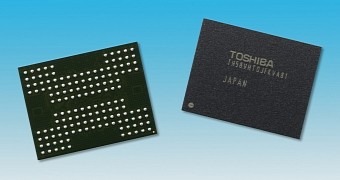Toshiba has recently announced that its new NAND flash memory packages can reach capacities of 128GB and 256GB when they stack eight or 16 dies of NAND flash packages.
The new flash packages are said to be designed for users and clients that need high-density NAND flash storage, the most important of them being eSSDs (enterprise-class solid-state drives), and last but not least, mobile products. In other words, consumers should expect to see phones with greater internal memories appear on the market from now on.
The Japanese company claims that the new stacked flash memory packages can integrate 16 128Gb NAND memory modules by connecting them using silicon vias and electrodes, thus guaranteeing great performance with moderate power consumption. Toshiba also claims that the new chips are best suited for high bandwidth storage applications, best served in high-end enterprise SSDs.
The new stacked chips have a 1Gb/s data rate, 1.8V core voltage and 1.2V I/O voltage, while using half the energy today's Toshiba SSDs require on read/write operations.
Impressive, experimental, but not revolutionary
However, according to KitGuru, the 16-die NAND flash chips carrying 256GB capacity take the crown on the overall memory capacity availability. The current day top-end SSD manufacturers try to cram as many 64GB memory chips on the same PCB as possible, and 256GB 14nm chips will raise the overall memory availability to 16TB of NAND flash memory in a form factor roughly about the size of today's HDDs.
Right now, the new Toshiba chips are in prototype stage, and while the microarchitecture layout has been established and is functional, no commercial controllers are available to work with the new chip design, nor will they be when these new chips are made available on the market.
It's also interesting to see how the new NAND flash memories will fare against the new 3D XPoint from Micron, which promises "hundreds of times" better performance than the current NAND flash chips.
We are also curious to see how the two new technologies will evolve a few years from now, when the new PCIe 4.0 and the optically-based PCIe 5.0 are set to arrive.

 14 DAY TRIAL //
14 DAY TRIAL //